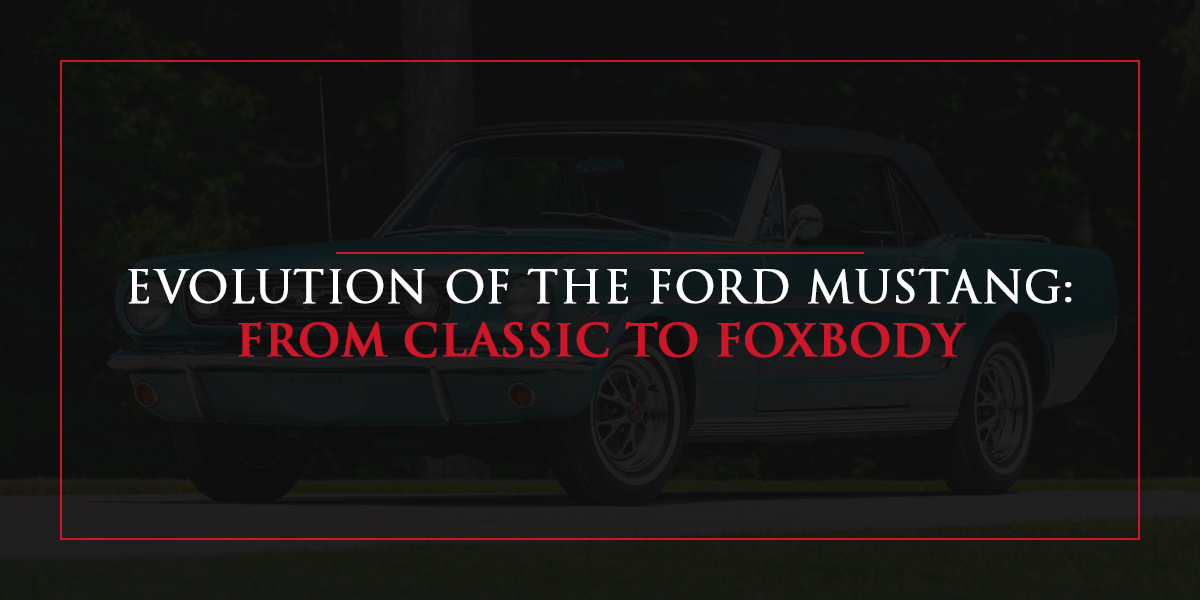
The Ford Mustang has been a highway staple for the past 60 years. Current year models sport a sleek design with rounded edges and sharp corners that merge into a fast and beautiful vehicle. No longer does the iconic stripe roll down the front of the vehicle. Instead, Ford opts for a half stripe down the center.
While most people recognize the current Mustang models by their iconic mustang logo along the front, the Ford Mustang has undergone drastic design changes, technical alterations and vehicle capabilities over the years. Most of these come along naturally with time as technology advances and newer regulations and safety protocols take effect.
It is always fun to take a step back and look at the vehicles’ roots and see where one of America’s most awe-inspiring and recognizable cars originated from.
Mustang Styles Through the Years
In the beginning, Ford did not expect Mustang sales to skyrocket to extreme highs. Shortly after, Mustang sales continued to fluctuate drastically, never quite reaching the same highs as the first two years of sales. Through those first couple decades, Ford continued to alter their Mustang line-up with the hopes of reaching the same high.
Thankfully, for many of us, Ford never faltered in their dedication to the Mustang, and they continued to experiment with different features, engines and styles to fit the needs of their consumers. During the evolution of the Mustang, these cars went through several major cosmetic redesigns, size changes and technological advancements. Let’s take a look at Mustang models by year.
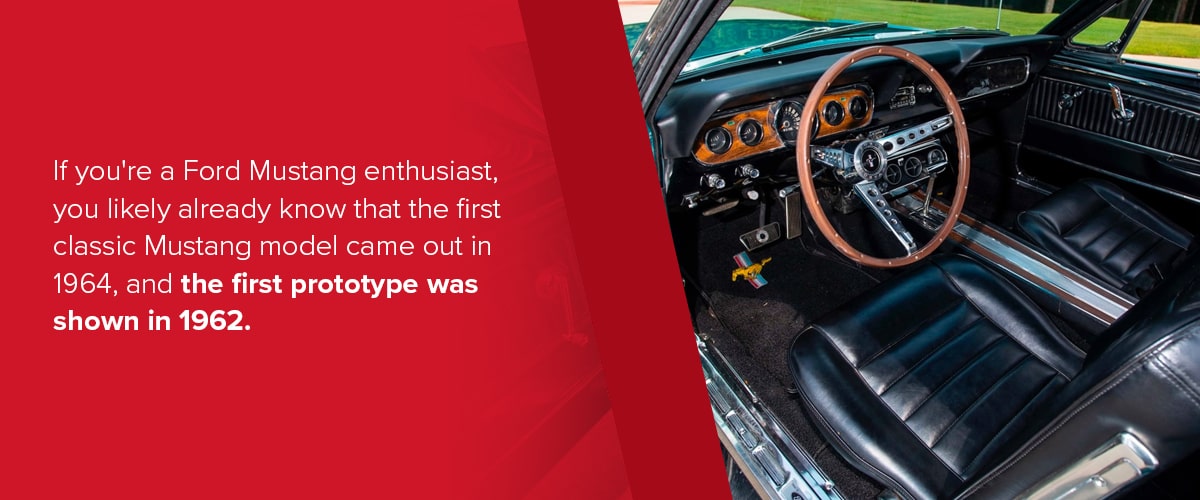
Prototypes of the 1940s-1950s
If you’re a Ford Mustang enthusiast, you likely already know that the first classic Mustang model came out in 1964, and the first prototype was shown in 1962. What most people won’t know about the Mustang is that evidence suggests an earlier prototype was created as early as 1948.
The rumors circulated after a black-and-white ad showed a vehicle with the name Mustang along the side. In the ad, it looks to have been made from a tubular frame with aluminum skin around it. It could hold up to six people, two in the bucket seats up front and four in a bench in the back. This vehicle had a 59 horsepower (hp) 4-cylinder water-cooled Hercules engine. It also had a rear axle and a Warner 3-speed transmission.
Unfortunately, no other information about this mysterious prototype exists beyond the ad. Any attempt to contact the McCarty family, the family mentioned in the ad, has led to only more deadends. Either way, if these rumors are to be true, then the first Mustang was conceptualized 12 years earlier than you might have originally believed.
Prototypes of the 1960s
The 1960s was one of the Ford Mustang’s busiest years in terms of major redesigns in body style, engine capabilities and technological additions. In the six years between 1962 to 1970, the Mustang had over four different models for consumers to choose from.
1962
Lee Iacocca, vice president and general manager of Ford, wanted to tap into the sporty youth market that could seat 4, had a floor-mounted shifter, was less than 180 inches long and weighed less than 2500 pounds.
As many of you will already know, the first known Mustang prototype was shown in 1962 and had a very noticeable rounded, spaceship exterior. It had a curved front end with a boxier top. While the look of the prototype has long since been abandoned, there were features already apparent of future Mustang models.
1964
In 1964, manufacturers released the first purchasable Ford Mustang to the public with a slightly different exterior concept than the prototype two years prior. This version came in multiple styles and with varying customization options. They could be purchased with either a convertible style or notchback with a 170-cid, straight-six, 4.3-liter V-8 engine or the acclaimed 289-cid V-8 engine with up to 271 hp.
These original Mustangs sold surprisingly well considering Ford’s estimated projections. However, these sales did not deter Ford from releasing a newer model only five months later. This short timespan gave the first Mustangs the nickname of the “64-and-a-half” year models.
1965-1966
With the help of Shelby America Ford released the Shelby Mustang, which would go on to be the beginnings of the “Cobra” line. These vehicles had multiple changes made to their overall appearance and components, making them more suited for racing. The Shelby Mustang used an alternator instead of the generator, relocated oil filler, integral power steering pump and a wire retaining ring around the gas cap.
Ford made ample in-house changes as well. The six-straight was enlarged to a 200-cid, 3.3L engine, and the 260-cid was replaced by a 289-cid with a two-barrel carburetor. A year later, the 1966 model had little alterations with mechanical components. Rather, these vehicles had more exterior cosmetic refinements that focused on chrome finishings around the grille and the removal of various logo placements.
1967-1968
It wasn’t until 1967 that the Mustang went through more dramatic enhancements. These models grew in length, width, height and weight to allow for bigger engines and tire smoking.
Ford dropped in a 390-cid, 6.4L V-8 with 320hp, overtaking the 289-cid engines as the top-performing engine in the factory lineup in 1967. Starting in 1968, you could also opt for a 302-cid, 4.9L V-8 engine which was the biggest small-block available in the Mustang at the time.
1967 also showed the first Mustang to be built around drag racing, which was known as the Cobra Jet. These engines were a powerful 428-cid, 7.0L V-8 that was underrated at the factory at 335 hp and had 440 pounds per foot of torque.
Cosmetically, the 1967 models went through major interior shifts as well. They had tilt-away steering wheels, overhead consoles, power disc brakes, all-new transmission with auto and manual shifting. Ford also removed the horizontal grille along the front and introduced more safety features. They included front and read side marker lights and folding, flush-mounted interior door pulls.
The following year, Mustangs came equipped with an AM/FM stereo radio and rear-window defoggers for added safety and entertainment.
1969
By the end of the decade, Mustangs had evolved from their original conception. These newer models were now heavier, more powerful and more aggressive than their predecessors. During this time, Ford released an assortment of new models for their Mustang line.
Of all of them, Boss 302 and Boss 429 took precedence over the other models. Ford built these two vehicles to meet the Trans-Am racing requirements. They were 3.8 inches longer and a half-inch wider. The 351-cid, 5.8L V-8 with 250 or 290 hp replaced the 289-cid engines. The Boss 429’s were able to have a 429-cid, 7.0L engine with up to 375 hp. Both Boss models introduced the iconic “shaker head” design, an air intake scoop on the hood of the cars.
One of the lesser-known models released the same year was the Mustang “E.” Bearing a similar resemblance to the Mustang Sportsroof models, the Mustang “E” had a six-cylinder engine but no air conditioner.
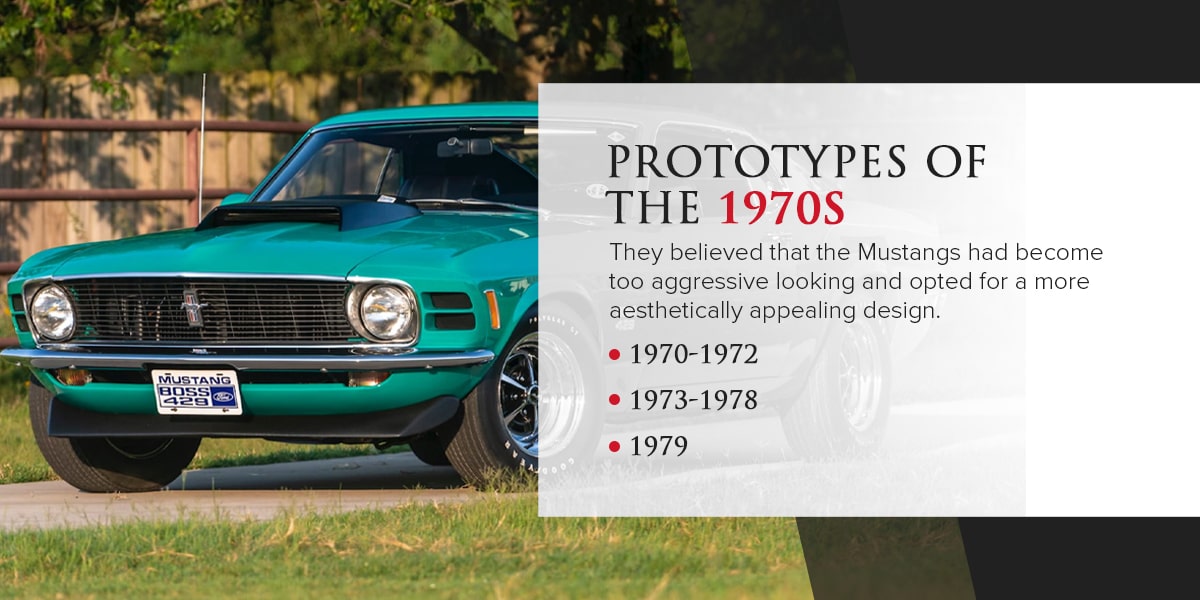
Prototypes of the 1970s
Unfortunately, with the turn of the decade, Ford noticed a decrease in Mustang sales. They believed that the Mustangs had become too aggressive looking and opted for a more aesthetically appealing design.
1970-1972
Between 1969 and 1970, Ford released another racing vehicle known as the Mach 1. The Mach 1’s functioned as an in-between consumer model. On one end, you had the residential and base Mustang models, and on the other, you had the speed demons built for racing the Boss 302’s.
Ford built the Mach 1’s with higher performance in mind. They had more power, more speed and bigger personalities. Each vehicle came equipped with dual-racing mirrors, a special side stripe and a pop-open gas cap. These models continued to sport the same “shaker head” design, which had become associated with racing. Some models also came with the new buttressed rear window installed.
1971 also saw the inclusion of the Boss 351 which replaced both the Boss 302 and Boss 429. This newer model had a specially designed 351-4V, 330 hp Cleveland engine. It had a four-speed transmission, dual exhaust and a more powerful front disc brake.
With the tightening of emission regulations, performance and muscle vehicles had a harder time meeting the necessary requirements. As a result, in 1972, Ford removed all of the Boss models from their lineup, leaving only the Mach 1as the available performance style model.
The six-straight engines were increased to a 250-cid, 4.1L. The 429-cid engine faded away, leaving the 351-cid as the biggest engine.
1973-1978
A decade after the first Mustang was released to the public, it had slowly increased in size and weight. The slimmer, earlier mustang model was now a bulkier version of itself.
When the Mustang II came out in 1973, Ford reduced the size of the car and compressed everything into a more subcompact design with a notchback or hatchback option. These newer engines consisted of a 140-cid, 2.3L and four cylinders. You could also choose the 171-cid, 2.8L V-6 engine.
1979
In 1979, Ford released the 3rd Gen Mustang, referred to among enthusiasts as the Foxbody. Available with three different engine configurations, starting with a naturally aspirated 2.3L four-cylinder engine making 88hp, a German Sourced 2.8L V6 making 109hp, and the venerable 5.0L V8 making 140hp. The V8 had Ford’s first use of a serpentine belt system on the V8 as well. This model also introduced some of the first turbocharged engines in a Mustang, though due to mechanical unreliability were shelved for the 1980 model year.
Prototypes of the 1980s
Mustangs went through another major redesign during the 1980s.
Around 1983, the turbocharged 2.3L returned with much greater reliability and power. Mustang also went back to having a built-in convertible feature after almost a decade of it being excluded. By 1987, the Mustang sported a more aero-themed style, flush headlights and new interior designs. Ford abandoned the V-6 engines, leaving only two engines and two models to choose from with this redesign.
Around the same time, the Ford Mustang LX could be optioned with the 5.0L V-8. Considered by many to be a cleaner design, they lacked the lower bodyside skirts and louvered taillights of the GT but packed the same punch. Those looking for a more relaxed cadence could still opt for the 2.3L in the LX configurations.
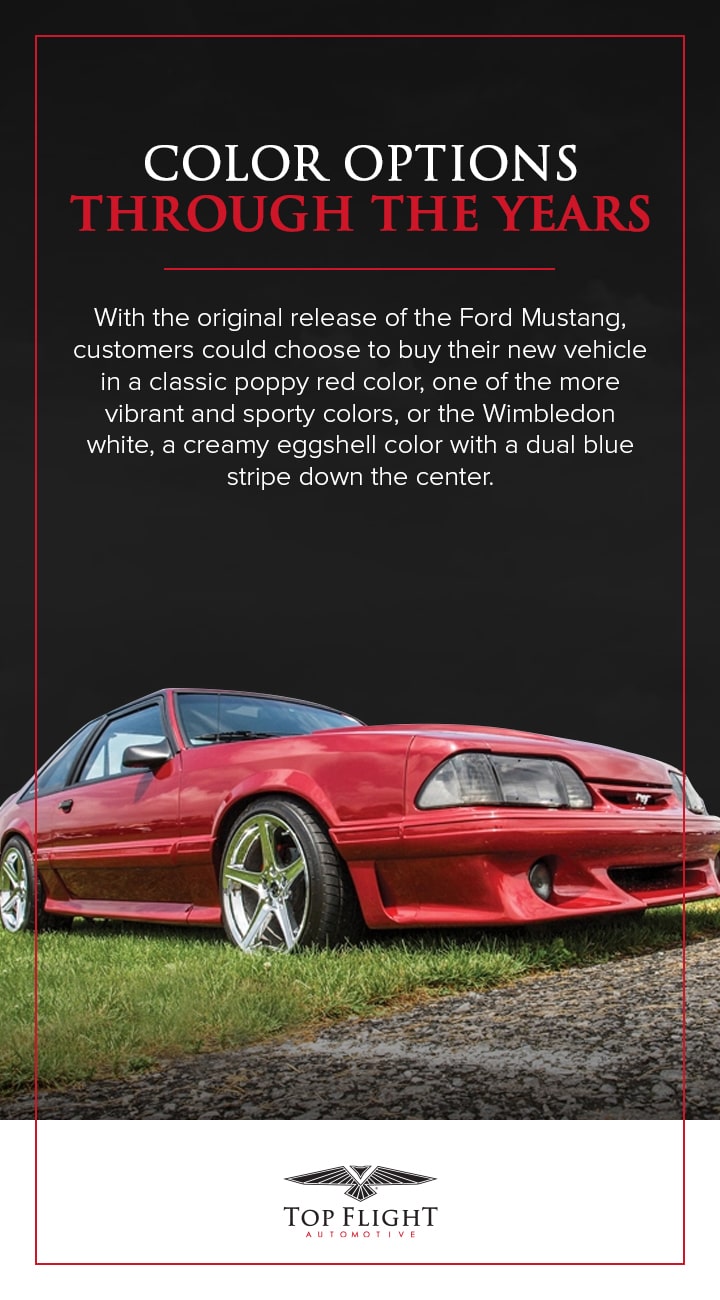
Color Options Through the Years
Through the years, Mustangs underwent some very daring and bold color options. While some only stuck around for the first several years of the Mustang’s lifetime, others have found comebacks in more recent years.
With the original release of the Ford Mustang, customers could choose to buy their new vehicle in a classic poppy red color, one of the more vibrant and sporty colors, or the Wimbledon white, a creamy eggshell color with a dual blue stripe down the center.
Shortly after, colors like the emberglo became popular amongst current consumers. At the time, emberglo was only available for one year in 1966 and wasn’t one of the popular color options. Nowadays, it is a popular find amongst collectors. In 1968, the highland green, a darker, almost black shade of green was a customer favorite at the time.
The Grabber Colors
Between 1969 and 1971, Mustangs were easily recognizable by their unique grabber coloring. Coming in a variety of different color options, the grabber brand was meant to grab the attention of anyone looking at it.
From 1969 to 1971, Ford released one of the first grabber colors. This available color was the iconic blue, grabber color. Interestingly enough, this color was not intentionally designed by Ford for use. During the painting of one of the vehicles, paint was running low, so the Petty brothers decided to mix the remaining dark blue with the white they had on hand. The result was grabber blue, which continued to reappear throughout the years.
In the same years, customers could choose a variety of other grabber options, such as grabber orange, green, yellow and lime. Each one was meant to stand out amongst the host of other companies and their own color options. The grabber choices demonstrated a more vibrant and dazzling color option. If you drove a Mustang with any of these colors, you were bound to stand out.
Remembering the Past
In such a short time, the Ford Mustang has undergone numerous stylistic and technical advancements. From its earliest prototype in 1948 to the compacted aero-design of the 1980s, Mustangs have seen an increase in bigger engines, more customization options and other various technical and cosmetic alterations. Despite any hardships that Ford Mustangs faced during their first decades of life, the vehicle make is still going strong. Ford is still tweaking the current S550 and re-introduced the Mach 1 this past spring!
Whether you are a collector of older Mustangs who has been around since the beginning or a current enthusiast of the newer Mustang models, learning the history and characteristics of the past is always an entertaining and informative time. Not only will you learn more about the history of your favorite car, but you may feel a deeper appreciation for the trials and tribulations that Mustangs underwent to get where they are now.



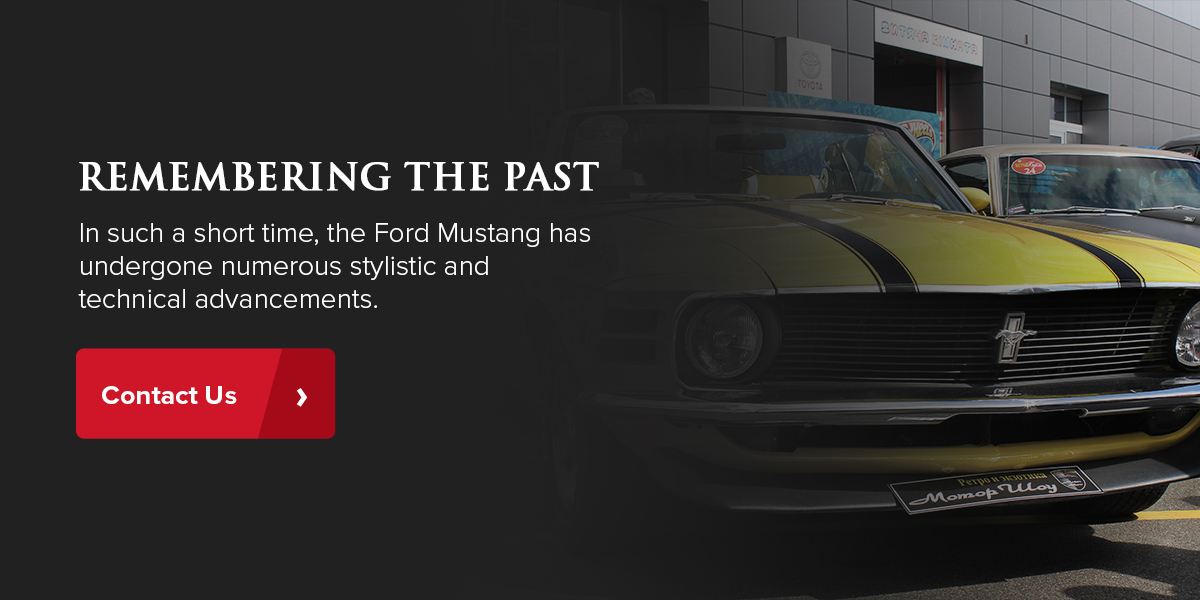







Leave a Response